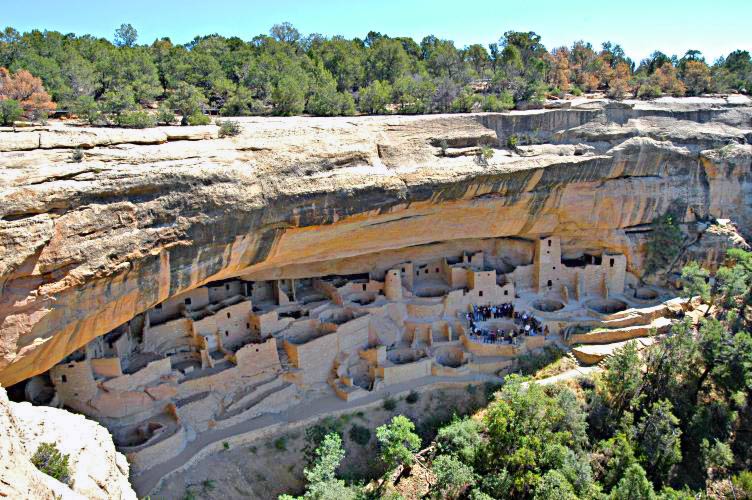
1) “Cliff Palace” at Mesa Verde National Park
Sometimes archaeological discoveries are made by accident. This has happened many times throughout history. A great example with Richard Wetherill and his brother in law Charles Mason. The two were ranchers in Mesa Verde in the southwest Colorado area. On December 18, 1888 the brothers rode to a cliff, herding cattle, where they unexpectedly saw a ruined site built into a cliff. Richard would go on to describe it saying that it was arranged in a way that made it seem like they were “visiting.” Richard came up with the name for this mind blowing site: “The Cliff Palace.”

2) Pueblo Mug
went into the site and found extremely well preserved pieces of pottery and other interesting artifacts. He saw the 150 rooms and 23 kivas that made up the site. Through much more research and work on the dwelling many conclusions were able to be drawn about the people that lived and created this site. Archaeologists determined that the people who lived here were the Ancestral Pueblos from the Pueblo III period. The Ancestral Pueblos were thought to have built the site in the 1200s. They were said to have moved to the area in order to ensure safety and a warmer, drier climate. Living in the cave area also helped keep everything in the site extremely well preserved. The artifacts were protected from pot-hunters and the buildings were protected from weathering effects because of its hidden cliff location. There were an estimated 625 people who lived in this dwelling. The people all had rooms for family and then they would share a Kiva for their ritual gatherings. A Kiva is an underground, excavated room for people to practice their religion. Extended family members would share these in order to perform their ceremonies.
At the Cliff Palace many artifacts were able to be found. It is stated that baskets, sandals, jewelry, textiles, and pottery were found. Pottery being the most important. Pottery showed skill and technology at this time. The Ancestral Pueblos living here were starting to make the pottery multi-colored as well. Another important thing found at Cliff Palace was Macaw feathers. These feathers were extremely significant because they were from Central America, showing trade.
Now Cliff Palace is a part of the Mesa Verde National Park. Thousands of people from around the world come and visit to see the amazing site year round. With these tours the area and buildings have been seeing more rapid deterioration. With this there are conservation efforts in place trying to keep the site as long as possible.
References
Simmons, Marc. “Trail Dust: Mesa Verde Pioneer Richard Wetherill Met a Tragic End.” Santa Fe New Mexican, June 5, 2015.
Yongli. “Cliff Palace.” Articles | Colorado Encyclopedia, May 25, 2016. https://coloradoencyclopedia.org/article/cliff-palace.
“Artifact Gallery.” National Parks Service. U.S. Department of the Interior. Accessed September 25, 2022.
Links
https://www.khanacademy.org/humanities/ap-art-history/indigenous-americas-apah/north-america-apah/a/mesa-verde-cliff-dwellings
https://www.santafenewmexican.com/news/trail_dust/trail-dust-mesa-verde-pioneer-richard-wetherill-met-a-tragic-end/article_bfe75db8-4ba6-56e6-b4d8-aa5eab2d3d7b.html

Take a look at Indigenous (especially Ute) perspectives on the cliff dwellings at Mesa Verde. How can their interpretations of the site help us understand the archaeological interpretation of Cliff Palace?
The Ute people were amazed by the discovery of the cliff dwellings at Mesa Verde. The Utes were so amazed they had to make sure that they could keep the area in their 125,000 acres of reservation.